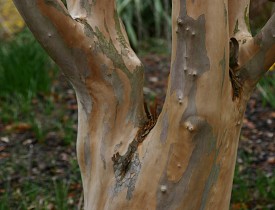18 Trees with Beautiful Bark
 I look forward to every season in the garden and to the unique charms and qualities that each has to offer. In winter, a blue sky day is the ideal time to appreciate trees, both native and exotic, with ornamental bark. Some like crape myrtle, kousa dogwoods and Stewartia species offer not only handsome bark that shines in winter but beautiful blooms too, during the growing season. And certain trees like the native American sycamore or the crape myrtle ‘Natchez’ look good no matter what the season.
I look forward to every season in the garden and to the unique charms and qualities that each has to offer. In winter, a blue sky day is the ideal time to appreciate trees, both native and exotic, with ornamental bark. Some like crape myrtle, kousa dogwoods and Stewartia species offer not only handsome bark that shines in winter but beautiful blooms too, during the growing season. And certain trees like the native American sycamore or the crape myrtle ‘Natchez’ look good no matter what the season.
Whether peeling, patchy, colorful, shiny or dull, bark is an asset. When you plant trees with ornamental bark, think about siting them against a backdrop of evergreens or conifers which will help to show off their bark, especially in winter. Including one or more trees with showy bark in your garden will help create a landscape with year-round interest.
Below is a list of trees with noteworthy bark. All are good choices for specimens or focal points in the landscape. Most become more decorative as they mature over time. Some like river birch, Betula nigra ‘Heritage’, can get quite large and require lots of room to grow. A blend of colors, their colorful peeling bark can be easily appreciated from a distance or up close.
18 Bark Beauties
1. Trident maple: (Acer buergerianum) This tree has scaly, exfoliating bark that gets more ornamental with age, in gray, orange and brown. Zones 5 to 8.
2. Paperbark maple: (Acer griseum) Here's a tree that has peeling cinnamon-colored bark. Zones 4 to 8.
3. Japanese maple: (Acer palmatum ‘Bihou’) With yellow peachy stems, Japanese maple is a standout in the winter garden. Zones 5 to 8.
4. Japanese maple: (Acer palmatum ‘Sango Kaku’) This variety is striking, with coral-orange-red stems in winter. Zones 5 to 8.
5. River birch: (Betula nigra ‘Heritage’) River birch has peeling salmon-white bark. Zones 4 to 9.
6. Paper birch: (Betula papyrifera) Paper birch has chalk white bark. Zones 2 to 6.
7. European hornbeam: (Carpinus betulus) European hornbeam's bark is gray and muscle-like. Zones 4 to7.
8. Shagbark hickory: (Carya ovata) Big shaggy strips of bark attach at the center and curl up. Zones 4 to 9.
9. Kousa dogwood: (Cornus kousa) This tree has a patchwork of gray, tan, brown and orange. Zones 5 to 8.
10. American beech: (Fagus grandifolia) You can recognize American beech trees by their smooth, silver gray trunks. Zones 4 to 9.
11. European beech: (Fagus sylvatica) European beech trees have smooth gray bark. Zones 5 to 7.
12. Chinese parasol tree: (Firmiana simplex) This tree has dark green bark. Zones 6 to 9.
13. Crape myrtle: (Lagerstroemia ‘Natchez’) Crape myrtle has cinnamon-colored bark. Zones 7 to 9.
14. American sycamore: (Platanus occidentalis) Brown bark peels to reveal white inner bark. American sycamore is a large specimen tree that gets showier with age. Zones 4 to 9.
15. Chinese quince: (Pseudocydonia sinensis) Chinese quince has peeling sycamore-like bark. Zones 6 to 8.
16. Tall stewartia: (Stewartia monadelpha) Tall stewartia has cinnamon brown bark. Zones 6 to 8.
17. Japanese stewartia: (Stewartia pseudocamellia) Japanese stewartia has exfoliating gray, red and orange bark. Zones 5 to 7.
18. Lacebark elm: (Ulmus parvifolia) The bark of the lacebark elm sheds to reveal a patchwork of red, brown, green and gray. Zones 4 to 9.
Would you like to plant some of these striking trees in your yard? Hire an expert landscaping contractor.
Erica Glasener is a Networx writer.
Updated January 29, 2018.
Looking for a Pro? Call us (866) 441-6648

Landscaping Average Costs
Landscapers Experiences

New Low-Maintenance Landscaping To Update Our Yard

Garage Remodel: Converted To Deluxe Man Cave With Custom Cabinetry And Workbench



